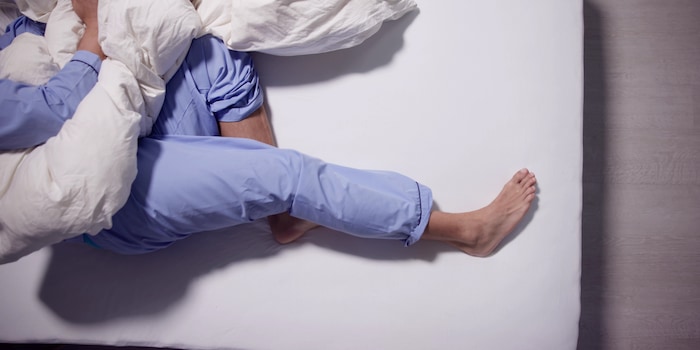
Background information
Hey men, the pelvic floor is not just a woman's thing!
by Ann-Kathrin Schäfer

They rock back and forth when you’re trying falling asleep, fidget when you’re sitting at the table. Sufferers of restless legs syndrome have no prospect of a cure. But there are ways and means of calming those twitching legs.
Ever sat next to a person who relentlessly moved their leg up and down like a sewing machine and slowly drove you nuts in the process? Maybe you’ve even done this in yourself. Fidgeting legs don’t necessarily equal ADHD or hyperactivity. More often than not, all this movement is caused by restless legs syndrome (RLS).
According to current research, between 5 and 10 per cent of people over 18 in Europe are affected by the neurological disorder – women slightly more than men. The risk of developing RLS increases as you get older, rising to 23 per cent for people who are 40 or older.
Affected people experience a pulling, tingling and pain in the lower extremities. But there are more signs. The following symptoms are signs of RLS:
For an initial self-assessment, there’s this RLS self-test questionnaire (test in German). However, it doesn’t replace a diagnosis by a medical professional.
Restless legs can also be caused by other things including iron deficiency (often the case during pregnancy), kidney or thyroid gland issues. To rule out other illnesses, it’s therefore essential for a doctor to do a blood test.
As a next step, taking an L-dopa test may confirm the suspicion of RLS. The test involves taking a drug that releases dopamine in the brain, which influences the signal transmission of the nerve cells. If L-dopa improves the symptoms, there’s a strong likelihood of restless legs syndrome.
Incidentally, other pre-existing conditions including type II diabetes, multiple sclerosis and polyneuropathies (diseases of the nerve cells) as well as pregnancy can also lead to RLS. In pregnancy, the cause of RLS is often iron deficiency, which can be treated.
The disorder is also hereditary to a certain degree. If someone in your family’s affected by RLS, there’s an increased probability you’ll develop it.
For people with milder symptoms, there are a few things that can be done.
Pregnant women are recommended to take various supplements, switch to a more iron-rich diet or even an iron infusion to compensate for iron deficiency during pregnancy. However, this should only be done after consulting your family doctor or a gynaecologist. Hormonal changes may also be the reason for restless legs during pregnancy. However, research into this has not yet yielded any conclusive results.
In addition, the independent Institute for Quality and Efficiency in Healthcare IQWiG (in German) reported on the results of new studies in an article published in August 2023. It states that symptoms such as tingling and the urge to move can also be treated and alleviated with the following:
In general, exercise can help alleviate the symptoms of milder forms of RLS. This was concluded by a study from the USA, for one, which focused primarily on the positive effects of yoga exercises. The exercises promote circulation and provide relief for restless legs.
If possible, RLS sufferers should also avoid sitting for long periods of time. Taking regular breaks, using a standing desk and taking phone calls while you’re walking can be ways of at interrupting long sedentary periods.
Header image: ShutterstockNotebook, camera, laptop or smartphone. For me, life's about taking notes – both analogue and digital. What's always on me? My iPod Shuffle. It's all in the mix, after all. This is also reflected in the topics I write about.
Interesting facts about products, behind-the-scenes looks at manufacturers and deep-dives on interesting people.
Show allIf the diagnosis is still inconclusive, polysomnography can be used in the sleep laboratory to «provide solid proof of both the typical recurring leg movements during sleep (PLMS) and the disruption of the sleep structure due to the countless wake-up responses», writes neurologist and sleep physician Dr Heike Beneš in a specialist article (in German) published in the German medical magazine «Der niedergelassene Arzt» (English: The established doctor).
Whether you can permanently combat RLS with L-dopa is something only your doctor can answer. The German Restless Legs Association (in German) also provides a good overview of treatments with medication. In any case, the drug seems to be the go-to solution for milder cases. It’s also been shown that many active substances used in Parkinson’s research also work for RLS patients.
But for around 1 to 3 per cent of people affected, the symptoms are so severe that often only opiates provide relief. Cold therapy may also help in severe cases of RLS. A small pilot study (in German) conducted at the Bremen-Ost Clinic has shown significant success, meaning this type of therapy may be a possible alternative or supplement to conventional drug treatment in isolated cases.
In addition, affected people also found cooling ointments, massages and foot baths to be helpful, as well as an anti-inflammatory diet. This means avoiding so-called empty carbohydrates such as wheat semolina, white rice, white bread and pasta. It also involves reducing sugar and meat in general but especially pork. Vegetables, legumes and other plant-based products such as tofu are great alternative sources of iron. The classic mock grains amaranth, quinoa and buckwheat also contain iron.

Kraftwerk Mobilio 4er Standard-Kombi